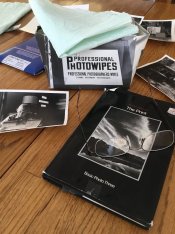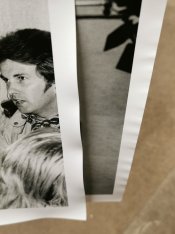My system above works well, and is fast and archival: I tried it again yesterday and the prints look good, both FB GL and FB Matte. Wash the prints 10 minutes in the sink under running water, give them a 10 minute soak in hypo clear, and then 10 minutes under running water. Run the bathroom shower w/ hot water w/ the door closed. Take the prints out of the drained sink, put them in a bucket and bring to the bathroom. Shut the door immediately. The prints are hung by one corner w/o squeegeeing on a line across the top of the shower stall, and then spritzed on the front and back w/ distilled water.
That's it. I go in after an hr or two and unpeg the prints at their top corner and turn them 180 degrees to be pinned again. A few I wanted to see dried right away, so I used a hair dryer. It took maybe 10 minutes of holding the top and working the hair dryer from one side to the other. It will try to curl, so just turn the paper and dry the back, side to side, top to bottom. Before this I had tried everything, and none of it worked. Taping them w/ watercolour tape to glass was a disaster. The prints were still able to pull out from the tape and dried terribly wavy all around.
So drying very slowly in a steamy bathroom works, and drying very fast and evenly works (which is what happens w/ a print dryer). A microwave works great too, but you have to work in small measures, maybe 5-10 seconds at a time, and you need a print that fits in one. My fb test strips are dried in there to speed things up a little. Be prepared for your matte prints/test strips to turn glossy if you use a microwave though!




